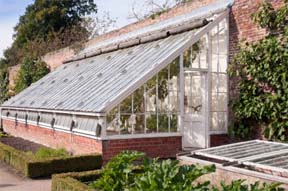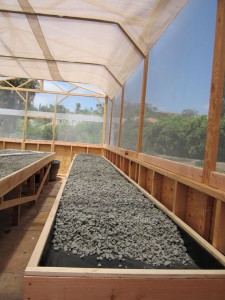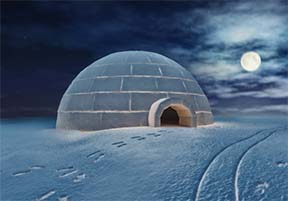New Energy-Saving Devices for Aquaponics in Cold Climates
– by Colle and Phyllis Davis
We receive many inquiries from people who live in very COLD climates who ask us, “Does aquaponics work in cold climates?”
And our answer is always, “YES IT DOES! In fact, it’s actually easier to heat a greenhouse than it is to cool a greenhouse!”
The energy cost of some aquaponics systems is so low it is almost a non issue. Many people chose to incorporate solar or other alternative power to operate their systems with great success. There are some new(er) technologies that may be helpful in planning an aquaponics installation or even retrofitting an existing installation.
 The first suggestion is the use of the outer wall of an occupied house as part of the (greenhouse) structure. Using the wall of a house as the north wall of the greenhouse makes perfect sense to protect the interior of a greenhouse structure from cold winds, and even if there is some electricity used to run the aquaponics system, on an annual basis, the greenhouse will have a CARBON NEGATIVE impact. Now really, how cool is that?
The first suggestion is the use of the outer wall of an occupied house as part of the (greenhouse) structure. Using the wall of a house as the north wall of the greenhouse makes perfect sense to protect the interior of a greenhouse structure from cold winds, and even if there is some electricity used to run the aquaponics system, on an annual basis, the greenhouse will have a CARBON NEGATIVE impact. Now really, how cool is that?
The insulated wall of a house means that the wall is never cold and much less heat is needed to keep the greenhouse above freezing. The second effect is having a door into the greenhouse in that wall so the greenhouse is entered from the house instead of entering the greenhouse directly from the outside. Two benefits here: The warm air from the house can enter the greenhouse and the cooler air can be warmed by the house’s heating system. But, “WAIT,” you say, “. . . that will cost money to heat.” Yes and when the sun comes out, heat moves back into the house and the runs the other way; heat from the greenhouse comes pouring into the house. Think GIANT solar heater.
 On clear sunny days, even in very cold weather, the heat gain in a greenhouse is very impressive. Even with outside temperatures ten degrees below freezing, the interior of a building-mounted greenhouse can very quickly raise into the comfortable-to-warm range. Now the greenhouse is reducing the heat load on the house itself and is now actually contributing to lowering the heating costs. The small amount of heat needed to keep the greenhouse above 50° F (4° C) is very quickly paid back on sunny days no matter what the temperature outside happens to reach. (Greenhouse needs to be a minimum of 65 degrees F with additional grow lights to extend the length of the day during winter months to grow blooming vegetables like tomatoes, peppers, cucumbers.)
On clear sunny days, even in very cold weather, the heat gain in a greenhouse is very impressive. Even with outside temperatures ten degrees below freezing, the interior of a building-mounted greenhouse can very quickly raise into the comfortable-to-warm range. Now the greenhouse is reducing the heat load on the house itself and is now actually contributing to lowering the heating costs. The small amount of heat needed to keep the greenhouse above 50° F (4° C) is very quickly paid back on sunny days no matter what the temperature outside happens to reach. (Greenhouse needs to be a minimum of 65 degrees F with additional grow lights to extend the length of the day during winter months to grow blooming vegetables like tomatoes, peppers, cucumbers.)
Insulation can be used on the non heat/light gathering areas. The entire north side of the greenhouse can be insulated with 4 to 8” of insulation. Painting the interior of the insulated side a bright white reaps the advantages of the insulation and the bright white bouncing the light around. The east and west walls can be insulated up to the 3 or 4’ level with no loss of effectiveness in the sun capture.
A stem wall is the wall surrounding a greenhouse (image below)
 Stem walls around the side of the greenhouse structure can be insulated or in warmer climates, can simply be concrete block to raise the overall height of the greenhouse to enclose more volume of air making the system more effective and easier to control.
Stem walls around the side of the greenhouse structure can be insulated or in warmer climates, can simply be concrete block to raise the overall height of the greenhouse to enclose more volume of air making the system more effective and easier to control.
Roof vents instead of exhaust fans are also effective. Roof vents are the modern trend in greenhouse design and with these vents and their air intake vents screened, the insect problems are vastly reduced to almost nil. The reductions in energy costs are amazing. The small motors that control the vent mechanisms require a very small amount of electricity and are only ‘on’ for a few minutes each day.
Solar heating for the fish tanks can also be done relatively inexpensively and with few, if any, electrical requirements, these systems quickly pay for themselves.
Solar panels to provide the electrical needs of the installation have come down dramatically in price over the last decade and with the reduced needs of the installation, the cost of going solar has become both viable and a cost savings.
Monitoring systems are still a bit expensive, but the need to monitor any aspect of the installation may be reduced to the point of only needing catastrophic failure notification.
There are other small tweaks that can be incorporated into any aquaponics greenhouse to reduce the energy requirements and each time these requirements are lowered, the ROI becomes better and better. Let the imagination run wild or contact PFAS LLC for more information on improving that current or dream aquaponics greenhouse.

2 comments
I am looking at using earthbag walls inside a 16X32 hole in the ground with the roof above ground at a 60 degree angle, in a cold area of Utah, 6,000 altitude, for a greenhouse. Is this feaseable, do you have anyone who can help engineer this?
Author
Jan,
You will be much better served to use concrete walls because they are MUCH easier to keep clean. Your roof angle is a bit extreme and will make extra work for you as well as being inefficient on a cost vs heat basis. Having any dirt inside a structure housing a Portable Farms® Aquaponics Systems is creating problems of contamination. A local contractor who builds basements will have the knowledge and expertise to engineer the enclosure.
Good luck and we look forward to having you as a student.
Colle